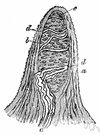papilla
(redirected from papillae)Also found in: Thesaurus, Medical, Encyclopedia.
Related to papillae: Fungiform papillae, Circumvallate papillae
pa·pil·la
(pə-pĭl′ə)n. pl. pa·pil·lae (-pĭl′ē)
1. A small nipplelike projection, such as a protuberance on the skin, at the root of a hair or feather, or at the base of a developing tooth.
2. One of the small, round or cone-shaped protuberances on the top of the tongue that contain taste buds.
3. A pimple or pustule.
4. Botany A minute projection on the surface of a stigma, petal, or leaf.
[Latin, nipple, diminutive of papula, swelling, pimple.]
pap′il·lar′y (păp′ə-lĕr′ē, pə-pĭl′ə-rē) adj.
pap′il·late′ (păp′ə-lāt′, pə-pĭl′ĭt) adj.
pap·il·lose (păp′ə-lōs′, pə-pĭl′ōs′) adj.
American Heritage® Dictionary of the English Language, Fifth Edition. Copyright © 2016 by Houghton Mifflin Harcourt Publishing Company. Published by Houghton Mifflin Harcourt Publishing Company. All rights reserved.
papilla
(pəˈpɪlə)n, pl -lae (-liː)
1. (Zoology) the small projection of tissue at the base of a hair, tooth, or feather
2. (Zoology) any other similar protuberance
3. (Botany) any minute blunt hair or process occurring in plants
[C18: from Latin: nipple; related to Latin papula pimple]
paˈpillary, paˈpillar, ˈpapillate, ˈpapillose adj
Collins English Dictionary – Complete and Unabridged, 12th Edition 2014 © HarperCollins Publishers 1991, 1994, 1998, 2000, 2003, 2006, 2007, 2009, 2011, 2014
pa•pil•la
(pəˈpɪl ə)n., pl. -pil•lae (-ˈpɪl i)
any small, nipplelike projection, as on the surface of the tongue or at the root of a developing hair.
[1400–50; late Middle English < Latin: nipple, teat, diminutive of papula pimple. See pap2]
pap•il•lar•y (ˈpæp əˌlɛr i, pəˈpɪl ə ri) adj.
Random House Kernerman Webster's College Dictionary, © 2010 K Dictionaries Ltd. Copyright 2005, 1997, 1991 by Random House, Inc. All rights reserved.
pa·pil·la
(pə-pĭl′ə) Plural papillae (pə-pĭl′ē)
A small projection from a body surface, especially a taste bud on the tongue.
The American Heritage® Student Science Dictionary, Second Edition. Copyright © 2014 by Houghton Mifflin Harcourt Publishing Company. Published by Houghton Mifflin Harcourt Publishing Company. All rights reserved.
papilla
A tiny nipple-shaped projection.
Dictionary of Unfamiliar Words by Diagram Group Copyright © 2008 by Diagram Visual Information Limited
ThesaurusAntonymsRelated WordsSynonymsLegend:
Switch to new thesaurus
| Noun | 1. | papilla - (botany) a tiny outgrowth on the surface of a petal or leaf |
| 2. |  papilla - a small nipple-shaped protuberance concerned with taste, touch, or smell; "the papillae of the tongue" papilla - a small nipple-shaped protuberance concerned with taste, touch, or smell; "the papillae of the tongue"sense organ, sensory receptor, receptor - an organ having nerve endings (in the skin or viscera or eye or ear or nose or mouth) that respond to stimulation | |
| 3. | papilla - a small projection of tissue at the base of a hair or tooth or feather |
Based on WordNet 3.0, Farlex clipart collection. © 2003-2012 Princeton University, Farlex Inc.
Translations
pa·pil·la
n. papila, protuberancia esp. en la lengua;
acoustic ___ → ___ acústica;
dermal ___ → ___ dérmica;
duodenal ___ → ___ duodenal;
filiform ___ → ___ filiforme;
lacrimal ___ → ___ lagrimal;
lingual ___ → ___ lingual.
English-Spanish Medical Dictionary © Farlex 2012
papilla
n papilaEnglish-Spanish/Spanish-English Medical Dictionary Copyright © 2006 by The McGraw-Hill Companies, Inc. All rights reserved.